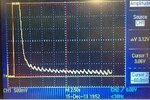patan.gova
Full Member level 3
Hello,
I am working with the pulse signals.My circuit is working fine but the output of the photodiode (pulse signal) is taking some settling time(shown with RedBox in the attached image) to come a an standard voltage level.
in the attached image) to come a an standard voltage level.
The output of the photodiode will be taken by switching it ON and OFF for some particular interval.I want to remove this settling time because when I want to take the output signal after 10sec of switching it ON then I don't get desired pulse signal as this will be still in settling stage.
Can anyone suggest how to remove the settling time.
Thanks.
I am working with the pulse signals.My circuit is working fine but the output of the photodiode (pulse signal) is taking some settling time(shown with RedBox
 in the attached image) to come a an standard voltage level.
in the attached image) to come a an standard voltage level.The output of the photodiode will be taken by switching it ON and OFF for some particular interval.I want to remove this settling time because when I want to take the output signal after 10sec of switching it ON then I don't get desired pulse signal as this will be still in settling stage.
Can anyone suggest how to remove the settling time.
Thanks.

